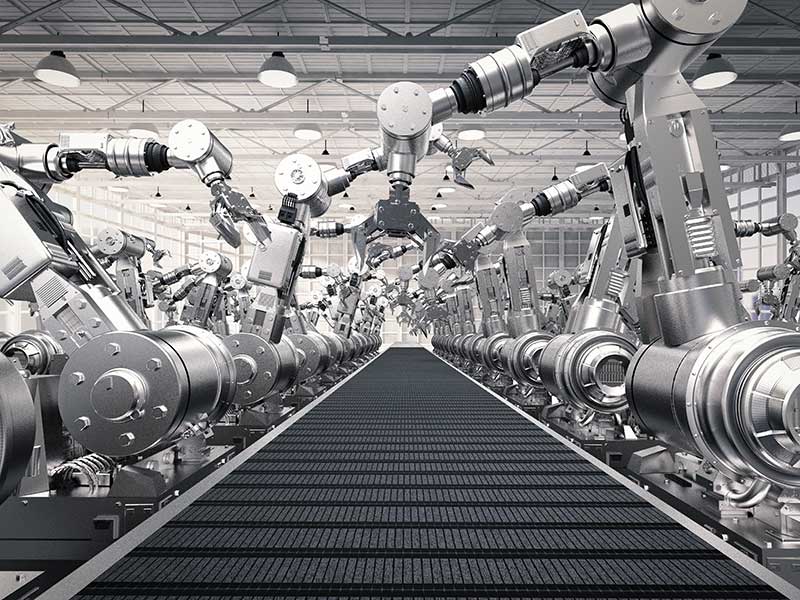Manufacturing is the answer. I know this because back in May of this year I stood in front of Australia’s first gigafactory in the making. In Tomago, New South Wales-based company Energy Renaissance (ER) is developing a local solution to the global demand for lithium-ion batteries.
This facility is unlike anything else in the world because ER designed, engineered and developed these batteries and its facilities for the peculiarities of high-temperature and humid environments, endowing ER with a valuable point of difference in the global battery market.

When the Advanced Manufacturing Growth Centre (AMGC) first encountered the leadership team at ER, they were ambitious, had an audacious yet compelling proposal, a talented team, and the intent to meet an untapped global market need by leveraging our abundant natural resources.
What they did not have was the monetary backing of the financial market. AMGC saw what others did not and embarked on the first of two co-invested projects with ER to develop its technology and facilities.
Later this year, the company will commence production, employing hundreds of locals in the growing renewable energy sector drawn from a region that once existed solely for commodities extraction.
Manufacturing competitive capability
ER’s story is not unique to us. But it demonstrates the potential manufacturing has to transform our country from lucky – reliant on commodities trade – to smart manufacturing world-leading technologies for local and global use.
My colleagues and I have met with thousands of determined manufacturers just like ER and to date have co-invested in 141 promising projects. These are ambitious and commercially promising projects, yet lacked early-stage financial and advisory support.
From the depths of the oceans to the expanses of space, AMGC’s co-invested projects are expected to generate 4,000 new, highly skilled, and well-paid roles and on completion will return $1.6 billion to the economy – all from $57 million of federal and state funding.
These project outcomes are not the consequence of uninformed risk-taking, it is the outcome of leveraging AMGC’s depth of understanding of the power and potential of Australian manufacturing and backing it.
Our projects address global needs such as advanced carbon-composite tanks for space, bio-manufacturing of algal proteins for use in food and medicines, value adding to local grains for plant-based proteins and the integration of recycled materials into products.
The various undertakings we support are not just about hammering something together but about embracing all steps of the manufacturing value chain.
Doesn’t it frustrate you to hear that “Australia is less complex than expected for its income level”?1 These are the ugly findings of the Harvard Business School, via its Economic Complexity Index (ECI).
Harvard systematically ranks countries by their ability to manufacture and export diverse and complex things. A country that can make such complex things is smart. A country that cannot, while still doing well, is just lucky. For now.
Australia is the eighth richest nation in the world, yet ranks 86th on the ECI, between Paraguay and Uzbekistan. This places us lowest of any Organisation for Economic Co-operation and Development (OECD) nation and a far cry from our highest ranking of 55th in 1995.
We can do better, and soon we must do better.
Growing our manufacturing capability would improve our ranking and generate the money and jobs required for our nation’s future.
We need to manufacture complex products instead of extracting base elements and shipping them abroad. Targeted investment in manufacturing is not about subsidies. It is about nurturing our raw talent of capabilities and building on our strengths.
Market mechanisms alone will not help Australia while other countries are investing in their manufacturing capabilities. So how do we improve Australia’s ability to make more complex things?
In one word: scale.
Germany recognised that for it to be a prosperous country that ran out of its commodities decades ago, it needed to make complex things and export them. Germany’s prosperity has been driven by the nation’s vibrant and innovative Mittelstand – the name given to describe the ecosystem of small-to-midsize enterprises (SME).
These companies employ fewer than 500 workers and account for 99.6 per cent of all firms in Germany. They employ 60 per cent of all working Germans and contribute to over 36 per cent of the nation’s GDP.
Their success was no accident. It was planned and supported by an industry policy and programs that sought to grow Germany’s manufacturing ecosystem.
It fostered collaboration, gave manufacturers the responsibility in training, and most importantly provided them a long-term vision via initiatives such as the Fraunhofer Institute, a 73-year-young organisation that has presided over continuous industrial growth.
By contrast, Australia’s manufacturing industry has been subjected to numerous short-term initiatives, and what you get in return for that is rank 86.
Advancing manufacturing is not about what you make but improving how you make it.
Manufacturing is diverse, technologically aligned, and interconnected. It operates in a dynamic, global trading environment where the imperative to make finished goods in one location is no longer the norm. 75 per cent of global trade today is in intermediate, unfinished goods. It is here that Australia has a substantive competitive advantage to tap into global alliances and programs to lift local capability and opportunities for manufacturers.
Manufacturing’s value chain
It is important to realise that manufacturing is more than production and is present wherever something is being made – in energy, food, vaccines, space, defence or medical equipment.
The manufacturing value chain consists of seven steps, each of which provides for highly skilled, well paid and resilient roles across disciplines including research and development, design, logistics, production, distribution, sales and service.
By taking this view, you discover the industry, directly and indirectly, employs about 1.3 million people – or over 10 per cent of the Australian workforce.
These figures are often dwarfed by the economic impact of our local mining sector, yet the truth is that manufacturing employs 3.5 times more Australians than mining and has been a stable contributor to our GDP for many decades, despite being misrepresented, misunderstood and ill-defined.
The real numbers of manufacturing are encouraging. However, if Australia wants to experience continued growth, then we will need to plan for change to ensure we retain a resilient economy beyond our dependency on commodities since nobody will buy our coal and gas in the future.
Doing so means bringing together the four key pillars of manufacturing: industry, government, public service and research.
Steps forward
I believe that only industry can lead the charge. We do have the evidence, not only by looking at highly successful industry nations but also at AMGC’s industry-led projects which are doing exceptionally well when our conditional co-investments encourage industry leaders to collaborate with our world-leading research institutions, supported by government and departmental programs.
Government support must be focused and consistent – have a plan and stick to it for 20 years.
You only need to look at those nations that occupy the top 10 places of Harvard’s ECI to see what success looks like. These nations have similar living standards, quality of education and high labour costs as Australia, yet they have long-term initiatives that foster industry growth, focused on their areas of strength and global competitiveness.
I would encourage policymakers to think of manufacturing as a national capability that permeates every industry of the economy.
By taking this view, it becomes clear that Australia must focus on fostering core capabilities such as people’s ability to develop complex products and solutions, use digital technologies, create and grow businesses, raise financing, and employ people in ways that suit personal choices – this must be led by industry and supported by government and educators.
This approach will enable Australia’s 47,000 manufacturers to follow market opportunities, upskill staff and move into adjacent and growing sub-industries of space, renewable energy, and adding value to commodities.
Manufacturers can benefit from playing a more significant role in delivering specific components that are fed into national, or international, complex supply chains to enable businesses elsewhere to assemble final products.
Final products are toxic for a small nation like ours: they make us feel bigger than we are but provide less economic value, especially when we don’t benefit from making the underlying subcomponents.
Investing in Australian manufacturing
The COVID pandemic and its associated supply chain shocks have become a catalyst for change. We must use this inflection point to accelerate the positive trends we were already seeing in Australian manufacturing to ensure we continue to foster a national capability that will serve us well for many years to come.
This approach could be seen in Australia in 2020 as the nation rushed to ensure it could manufacture ventilators and other supplies that might be urgently required. What we proved was that the nation’s capability to make ventilators did not rely on having an existing base of ventilator manufacturers.
Instead, it relied on having people and businesses that could quickly make such products by leveraging their capabilities. It is also these exceptional baseline technical skills and capabilities that we could turn to in future times of urgent and critical needs.
Is there any more evidence needed to demonstrate that manufacturing is a broad capability held by thousands of SME companies? Didn’t it show that Australia needs to foster this broad, horizontal capability to build its future and create wealth by addressing new challenges and opportunities as they arise?
All of this is arbitrary if sub-sized manufacturers are unable to access the funding they require to advance and scale. Many of AMGC’s members report that banks are unwilling to lend to companies to fund growth or new equipment purchases because banks as well lack the understanding of what manufacturing is and can be.
One way to address these issues is to better educate the financial community about manufacturing and especially how the industry and its capital requirements and prospects are changing.
Another way is to provide more risk capital to capable manufacturers and help them scale, like that of initiatives run by the Clean Energy Finance Corporation (CEFC).
Nurturing growth is one area in which AMGC excels. We have a streamlined process to make it straightforward for innovative manufacturers receiving co-investment and then report to government as those funds are delivering impact.
This is fundamentally different to grants. AMGC ensures that every dollar is accounted for, provides a measurable return to the nation and opens the door to business growth and non-governmental funding in the long term.
Despite the challenges, I know manufacturing is the answer. I have seen it, touched it and even purchased it.
By unleashing the power of manufacturing, leveraging collaboration and scaling we have a real opportunity to transform Australia from being a lucky country to a smart one.
We should not squander the opportunity to advance, leverage our natural and human capital and lead the world in its transition to a healthier future. In doing so, we can provide future opportunities for our nation and retain the way of life we know and love.
Dr Jens Goennemann is Managing Director of the Advanced Manufacturing Growth Centre (AMGC). Jens joined AMGC as the inaugural Managing Director in 2016 where he brings extensive experience from overseeing large manufacturing operations in Australia and Europe. He has previously held senior positions at Daimler-Benz Aerospace and Airbus Group.
Footnotes
Do you know more? Contact James Riley via Email.

